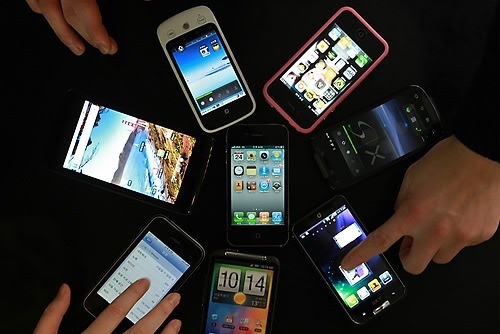The ongoing battle between the nation’s three mobile carriers ― KT Corp., SK Telecom and LG Uplus ― reached fever pitch this week following a request from KT to the government to put a desirable LTE frequency on sale so KT may purchase it.
“It would be an undeserving privilege for KT,” said its rival SKT in a statement on Wednesday.
The frequency that KT hopes to own is directly adjacent to its current frequency of 1.8 GHz, which would free KT from having to spend time and money building a broadband network because of the technological advantages of owning two adjacent frequencies.
 |
Customers test out various smartphones at a mobile phone store in Seoul.(Yonhap News) |

“KT then can claim to customers that its LTE speed has become twice as fast,” said Kim Ji-won, a spokeswoman for SKT.
“KT currently already has an LTE frequency, and when it gets the neighboring frequency as well, KT would eventually come to own a nationwide, broadband LTE network.”
The competition among the three mobile carriers is heated in a close race to gain a better footing in the faster, fourth-generation LTE network and LTE-Advanced.
SKT is in the lead with around 10 million subscribers, but KT and LG Uplus are neck-and-neck with around 6 million each, with KT slightly outpacing LG.
For SKT and LG Uplus, the frequency that KT is after is not as attractive, since their current frequencies are some distance away, meaning they could not hope to build a nationwide broadband network as KT could.
KT, meanwhile, says that the final decision is up to the government, and that it believes that there is nothing wrong with wanting the bandwidth to go on sale.
“It’s fair competition. All we want is a fair chance at this frequency,” said Jin Hyon-ho, a spokesman for KT Corp.
For KT, he added, it’s a matter of survival and about raising the quality of LTE services for its customers.
One other reason KT is so adamant about this new frequency is because the other frequency it possesses ― the 900 MHz band ― is unavailable due to radio interference.
“It wasn’t cleared when we first bought the frequency, and that’s why we need a new band,” Jin explained.
SKT, however, called on KT to take responsibility for its decision to purchase a faulty frequency. “KT needs to own up and solve its own problems,” the company said.
Carrier Aggregation, a technology used for realizing LTE-Advanced to increase the bandwidth, is another part of the fight between the three carriers.
All three telecom companies are working on this technology, which allows carriers to combine frequencies to create larger bandwidths. The problem is, should KT get to own the adjacent frequency, it would have a bigger advantage over even Carrier Aggregation.
In the meantime, all three mobile carriers are in discussions with the government to win favor in the frequency squabble. The Ministry of Science, ICT and Future Planning has refused to publicly comment on the issue.
By Kim Ji-hyun (
jemmie@heraldcorp.com)









